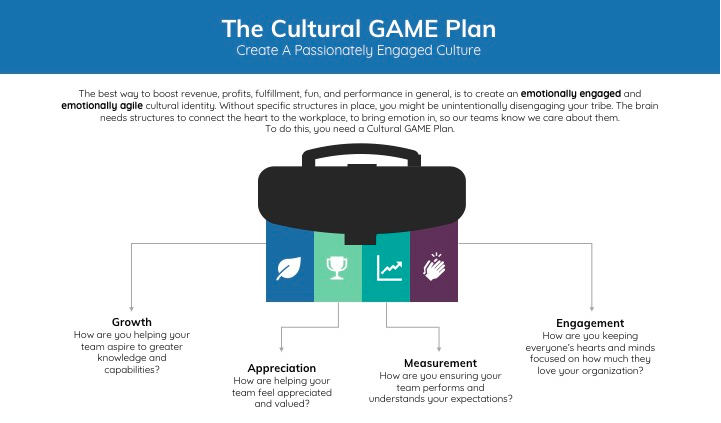Are you helping your team build trust and increase emotional agility?
All leaders need a GAME plan to build sustainable tribal agility. But you don’t need to reinvent the wheel. I’ll provide a template in a moment!

What Is a GAME Plan?
A Cultural GAME Plan provides cultural rituals so a person knows how to stay in the tribe (be safe and belong) and gain status (matter) in each of these four key areas. It not only establishes trust at the cultural level, but it also supports a fulfilling work experience, which will yield the happiest and most committed, productive, loyal, long-term, constantly evolving emotionally agile team members.


You deserve this. So do they.
GAME stands for the following:
- Growth: How are you helping your team to aspire to greater knowledge and capabilities?
- Appreciation: How are helping your team to feel appreciated and valued?
- Measurement: How are you ensuring that your team performs and understands your expectations?
- Engagement: How are you helping keep everyone’s heart and mind focused on how much they love your organization?
Your GAME Plan Recipe
1. Do an SBM Index survey to find what your tribe needs.
2. Create your GAME Plan based on your SBM Index findings. Your Cultural GAME Plan needs to encompass safety, belonging, and mattering throughout the entire employee experience (EX), which means you’ll want to include recruiting and onboarding, performance motivation, and ongoing talent optimization. This is how so many of my clients earn Best Places to Work awards—which make a huge difference in recruiting, retention, performance, and employee happiness overall.
What you include in your plan will be customized to your needs, but here are some examples of how to increase SBM through specific structures, tools, and rituals for growth, appreciation, measurement, and engagement. Note how each part of the plan maps to SBM Index results (S for safety, B for belonging, and M for mattering):
Growth: How are you helping your team aspire to greater knowledge and capabilities?
- Individual Development Plans (S, B, M)
- Leadership Lunches (B)
- Annual (Organization-wide) Learning and Development Plans (S, B, M)
- Feedback Frames (S, B, M) [need to link to recent feedback blog]
- Turnaround Processes (S, B, M)
Appreciation: How are you helping your team feel appreciated and valued?
- High Fives (M, B)
- Rock Star of the Month [M, B]
- Weekly Wins (S, B, M)
- Friday Toasts (M, B)
- Merit Money and/or peer-based bonus programs11 (B, M)
Measurement: How are you ensuring that your team performs and understands your expectations?
- Accountability Structures (S, B, M)
- Weekly Status (S, M)
- Dashboards (S, B, M)
- Performance Self-Evaluations (S, B, M)
- Engagement Surveys (such as the SBM Index) (S, B, M)
Engagement: How are you helping keep everyone’s heart and mind focused on how much they love your organization?
- Engaging mission, vision, and values statements (S, B, M)
- Impact Descriptions (S, B, M)
- Coffee with the CEO” program (B, M)
- Organization-wide contests (M, B)
- Diversity, Equity, and Inclusion Structures (S, B)
- Optimal recruiting processes (to ensure value alignment) (B)
- Optimal onboarding processes (S, B, M)
- Visual, auditory, and kinesthetic goals (goals you show that people are progressing toward V, talk about A, and anchor in an activity K) (S, B, M)
3. Implement your GAME Plan on a monthly basis. After the initial programs have been in place for six to nine months, complete a new SBM Index to assess results. A GAME Plan will span many months or even years as an organization rolls out relevant programs.

The table below shows the first month’s programs for a client’s GAME Plan based on their SBM Index results.
Note that what the organization craved most overall was belonging, so we put cultural rituals in place first to create connection and tribe. In the following months we would address safety and mattering as the experience of belonging was strengthened. In addition to the initial programs, we coached the investments leader to bring more safety to his team.
4. As you continue to implement your plan, you’ll enjoy increasing amounts of the benefits our clients love:
- Increased employee retention by more than 90 percent
- Increased profit per employee by over 22 percent
- Increased performance by 35 to 50 percent
- Increased emotional engagement, agility, and morale by 67 to 100 percent
- Decreased time to recruit for open positions by more than 50 percent
The Net-Net:
- A Cultural GAME Plan helps to foster a fulfilling work experience, which will yield the happiest and most committed, productive, loyal, long-term, constantly evolving, and emotionally agile team members. They will say, “I love my job, I trust my leader, and I’m ready to rock today!”
- This is true emotional agility and engagement.
————
Do you like to listen?
I’m known for creating strategies that are responsible for hundreds of billions of dollars in new revenue and company value. Imagine if I was able to sit down with you and SHARE all of my knowledge and insight!
Since that isn’t physically possible, my new podcast is the next best thing!
I use each episode of Crack the Behavior Code to give you a glimpse into my strategic approach to business and leadership. I bring you on a journey to leverage neuroscience-based tools in order to promote behavior change and begin understanding what all humans need (and how you can provide it)!

